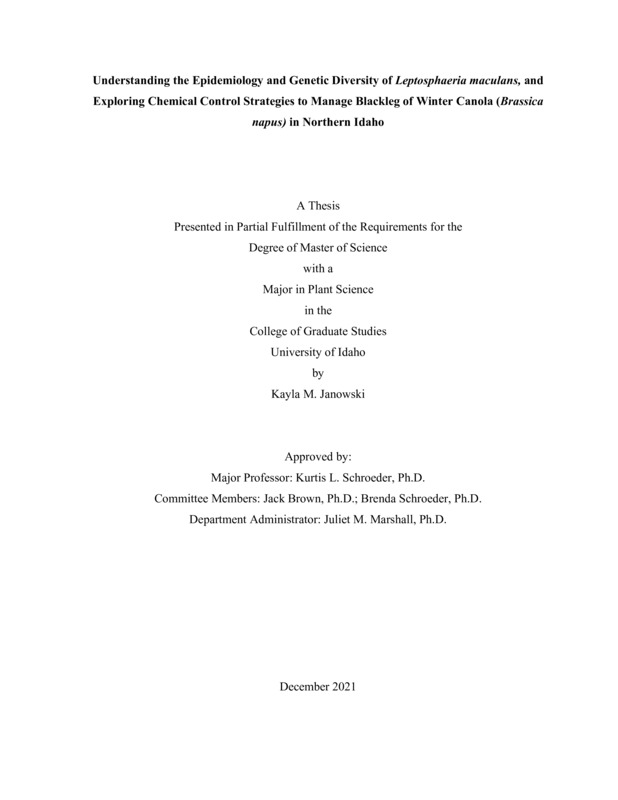Understanding the Epidemiology and Genetic Diversity of Leptosphaeria maculans, and Exploring Chemical Control Strategies to Manage Blackleg of Winter Canola (Brassica napus) in Northern Idaho
Janowski, Kayla M. (2021-12). Understanding the Epidemiology and Genetic Diversity of Leptosphaeria maculans, and Exploring Chemical Control Strategies to Manage Blackleg of Winter Canola (Brassica napus) in Northern Idaho. Theses and Dissertations Collection, University of Idaho Library Digital Collections. https://www.lib.uidaho.edu/digital/etd/items/janowski_idaho_0089n_12261.html
- Title:
- Understanding the Epidemiology and Genetic Diversity of Leptosphaeria maculans, and Exploring Chemical Control Strategies to Manage Blackleg of Winter Canola (Brassica napus) in Northern Idaho
- Author:
- Janowski, Kayla M
- Date:
- 2021-12
- Program:
- Plant, Soil and Entomological Sciences
- Subject Category:
- Plant sciences
- Abstract:
-
Blackleg disease of canola (Brassica napus), caused by the fungal pathogen Leptosphaeria maculans, is a major constraint of production worldwide. Blackleg can cause stem lesions and cankers, and in severe cases result in detrimental yield loss. In northern Idaho blackleg was first discovered in 2011 and is an emerging threat to canola seed production. Growers have access to multiple disease management practices for blackleg including crop rotations, stubble management, fungicide applications, and genetic resistance. An important element in overall management of blackleg is qualitative resistance where avirulence effector gene products in the pathogen are recognized by corresponding resistance gene products in the host. Leptosphaeria maculans isolates were collected from eastern Washington to elucidate the race structure. Greenhouse host plant differentials and PCR were used to characterize the following genes: AvrLm1, AvrLm2, AvrLm3, AvrLm4, AvrLm5, AvrLm6, AvrLm7, AvrLm 9, AvrLm11, AvrLepR1, AvrLepR2, and AvrLepR3. The highest frequency of effector genes present in the eastern Washington L. maculans pathogen population are AvrLm5 (100%), AvrLm6 (100%), AvrLm7 (100%), AvrLm11 (92%), and AvrLepR1 (100%). Eighteen unique race structures were observed with the three most common as follows: AvrLm3-5-6-7-11-LepR1-LepR2 (24%), AvrLm5-6-7-11-LepR1-LepR2-LepR3 (16%), and AvrLm3-5-6-7-11-LepR1-LepR2-LepR3 (15%). Determining L. maculans population demographics provides insight as to which canola cultivars with specific R-genes should be considered when growers and breeders are making management decisions. Other disease management practices should be used in conjunction with qualitative resistance to reduce the possibility of resistance breakdown events. Fungicides and disease forecasting have shown successful reduction of blackleg disease incidence when utilized in management programs. Ensuring successful disease prevention through foliar fungicide applications relies on identification of optimal spray timing for the region. Winter canola field trials were established on the Palouse (Moscow and Genesee, ID) and the Camas Prairie (Grangeville or Nezperce, ID) for 2 years to test the impact foliar fungicide application timing and fungicide seed treatment has on blackleg disease incidence, disease severity, and yield response in the region. Each trial was a split-plot experimental design where cultivar was the main plot and fungicide treatments were randomly assigned to the subplots across four replications. Treatments included: (1) two cultivars, Mercedes (resistant) and Amanda (susceptible); (2) fungicide seed treatment (Helix Vibrance) or no seed treatment (clothianidin); and (3) four foliar fungicide application timings (fall only, spring only, fall and spring, and no application). Seed treatment was not effective in reducing blackleg disease incidence and severity. Disease incidence and severity was significantly reduced when foliar fungicides were applied. No application resulted in disease incidence of 16% and 27% and for Mercedes and Amanda, respectively. Disease was significantly reduced in both cultivars with a fall only application (6% to 11%) and a spring only application (2% to 9%). Applying in both the fall and spring resulted in the lowest disease incidence (1% to 4%) for each cultivar. No application of foliar fungicide resulted in a disease severity rating of 0.22 (0-5 scale with 0 = no disease). A fall only application (0.10), spring only application (0.09) and both fall and spring application (0.02) reduced stem severity, indicating the importance of foliar fungicides in preventing stem canker formation. Yield response to foliar application timing had a p-value of 0.059, indicating disease did not cause serious stem canker formation, but use of a foliar fungicide has the potential to improve yields. No spray plots yielded 4,748 kg/ha. A fall only and spring only application increased yield to 4,905 kg/ha and 4,835 kg/ha, respectively, and applying twice resulted in a yield of 5,004 kg/ha. Because blackleg is new to northern Idaho, there is limited knowledge as to when spores are released, and initial infection occurs. Therefore, Burkard volumetric spore traps were deployed adjacent to the winter canola field trials on the Palouse and Camas Prairie and used to determine when spores are moving. At both locations, ascospores were released between March and June under average weekly temperatures between 3 and 16oC, relative humidity between 55 and 93%, and total weekly precipitation between 0 and 43 mm. Additional ascospore release may occur in the fall between September and October, but this was only observed on the Camas Prairie location in 2020. The results from this research contribute to our understanding of chemical control and the population structure of L. maculans in the region. This information is vital to developing a blackleg disease management plan specific to the production of winter canola in northern Idaho.
- Description:
- masters, M.S., Plant, Soil and Entomological Sciences -- University of Idaho - College of Graduate Studies, 2021-12
- Major Professor:
- Schroeder, Kurtis L
- Committee:
- Brown, Jack; Schroeder, Brenda; Marshall, Juliet M
- Defense Date:
- 2021-12
- Identifier:
- Janowski_idaho_0089N_12261
- Type:
- Text
- Format Original:
- Format:
- application/pdf
- Rights:
- In Copyright - Educational Use Permitted. For more information, please contact University of Idaho Library Special Collections and Archives Department at libspec@uidaho.edu.
- Standardized Rights:
- http://rightsstatements.org/vocab/InC-EDU/1.0/

